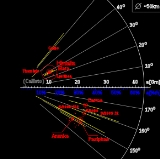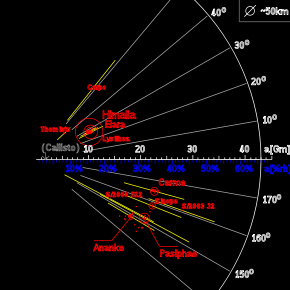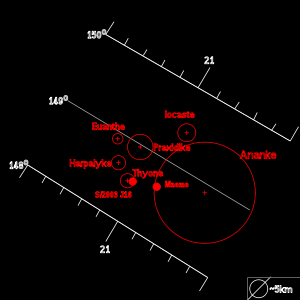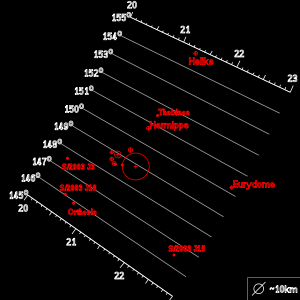
Ananke group
Encyclopedia
The Ananke group is a group of retrograde
irregular satellite
s of Jupiter
that follow similar orbit
s to Ananke
and are thought to have a common origin.
Their semi-major axes
(distances from Jupiter) range between 19.3 and 22.7 Gm
, their orbital inclinations between 145.7° and 154.8°, and their orbital eccentricities between 0.02 and 0.28.
 The core members include (from largest to smallest):
The core members include (from largest to smallest):
The International Astronomical Union
(IAU) reserves names ending in -e for all retrograde moons, including this group's members.
was captured by Jupiter and subsequently fragmented by a collision. This belief is founded on the fact that the dispersion
of the mean
1 orbital parameters of the core members is very small and can be accounted for by a small velocity impulse (15 < δV < 80 m/s), compatible with a single collision and breakup.
Based on the sizes of the satellites, the original asteroid may have been about 28 km in diameter. Since this value is near the approximate diameter of Ananke itself, it is likely the parent body was not heavily disrupted.
Available photometric studies add further credibility to the common origin thesis: three of the moons of the family (Harpalyke
, Praxidike
and Iocaste
) display similar grey colours (average colour indices
: B−V = 0.77 and V−R = 0.42) while Ananke itself is on the boundary between grey and light red.


1Osculating
orbital parameters of irregular satellites of Jupiter change widely in short intervals due to heavy perturbation by the Sun. For example, changes of as much as 1 Gm in semi-major axis in 2 years, 0.5 in eccentricity in 12 years, and as much as 5° in 24 years have been reported.
Mean orbital elements are the averages calculated by the numerical integration of current elements over a long period of time, used to determine the dynamical families.
Retrograde
-Retrograde:* Retrograde motion, in astronomy, describes retrograde motions of celestial bodies relative to a gravitationally central object* Apparent retrograde motion, in astronomy, is the apparent motion of planets as observed from a particular vantage point...
irregular satellite
Irregular satellite
In astronomy, an irregular moon is a natural satellite following a distant, inclined, and often eccentric and retrograde orbit. They are believed to have been captured by their parent planet, unlike regular satellites, which form in situ....
s of Jupiter
Jupiter
Jupiter is the fifth planet from the Sun and the largest planet within the Solar System. It is a gas giant with mass one-thousandth that of the Sun but is two and a half times the mass of all the other planets in our Solar System combined. Jupiter is classified as a gas giant along with Saturn,...
that follow similar orbit
Orbit
In physics, an orbit is the gravitationally curved path of an object around a point in space, for example the orbit of a planet around the center of a star system, such as the Solar System...
s to Ananke
Ananke (moon)
Ananke is a retrograde irregular satellite of Jupiter. It was discovered by Seth Barnes Nicholson at Mount Wilson Observatory in 1951 and is named after the mythological Ananke, the personification of Necessity, and the mother of the Moirae by Zeus...
and are thought to have a common origin.
Their semi-major axes
Semi-major axis
The major axis of an ellipse is its longest diameter, a line that runs through the centre and both foci, its ends being at the widest points of the shape...
(distances from Jupiter) range between 19.3 and 22.7 Gm
Gigametre
A gigametre is a unit of length in the metric system, equal to one billion meters, the SI base unit of length, hence to 1,000,000 km or approximately 621,370 miles....
, their orbital inclinations between 145.7° and 154.8°, and their orbital eccentricities between 0.02 and 0.28.

- AnankeAnanke (moon)Ananke is a retrograde irregular satellite of Jupiter. It was discovered by Seth Barnes Nicholson at Mount Wilson Observatory in 1951 and is named after the mythological Ananke, the personification of Necessity, and the mother of the Moirae by Zeus...
- PraxidikePraxidike (moon)Praxidike , also known as ', is a retrograde irregular satellite of Jupiter. It was discovered by a team of astronomers from the University of Hawaii led by Scott S...
- IocasteIocaste (moon)Iocaste , also known as ', is a retrograde irregular satellite of Jupiter. It was discovered by a team of astronomers from the University of Hawaii led by Scott S...
- HarpalykeHarpalyke (moon)Harpalyke , also known as ', is a retrograde irregular satellite of Jupiter. It was discovered by a team of astronomers from the University of Hawaii led by Scott S. Sheppard in 2000, and given the temporary designation '...
- ThyoneThyone (moon)Thyone , also known as ', is a retrograde irregular satellite of Jupiter. It was discovered by a team of astronomers from the University of Hawaii led by Scott S. Sheppard, et al...
- EuantheEuanthe (moon)Euanthe , also known as ', is a retrograde irregular satellite of Jupiter. It was discovered by a team of astronomers from the University of Hawaii led by Scott S...
- EuporieEuporie (moon)Euporie , also known as ', is a natural satellite of Jupiter. It was discovered by a team of astronomers from the University of Hawaii led by Scott S...
The International Astronomical Union
International Astronomical Union
The International Astronomical Union IAU is a collection of professional astronomers, at the Ph.D. level and beyond, active in professional research and education in astronomy...
(IAU) reserves names ending in -e for all retrograde moons, including this group's members.
Origin
The Ananke group is believed to have been formed when an asteroidAsteroid
Asteroids are a class of small Solar System bodies in orbit around the Sun. They have also been called planetoids, especially the larger ones...
was captured by Jupiter and subsequently fragmented by a collision. This belief is founded on the fact that the dispersion
Dispersion relation
In physics and electrical engineering, dispersion most often refers to frequency-dependent effects in wave propagation. Note, however, that there are several other uses of the word "dispersion" in the physical sciences....
of the mean
Mean
In statistics, mean has two related meanings:* the arithmetic mean .* the expected value of a random variable, which is also called the population mean....
1 orbital parameters of the core members is very small and can be accounted for by a small velocity impulse (15 < δV < 80 m/s), compatible with a single collision and breakup.
Based on the sizes of the satellites, the original asteroid may have been about 28 km in diameter. Since this value is near the approximate diameter of Ananke itself, it is likely the parent body was not heavily disrupted.
Available photometric studies add further credibility to the common origin thesis: three of the moons of the family (Harpalyke
Harpalyke (moon)
Harpalyke , also known as ', is a retrograde irregular satellite of Jupiter. It was discovered by a team of astronomers from the University of Hawaii led by Scott S. Sheppard in 2000, and given the temporary designation '...
, Praxidike
Praxidike (moon)
Praxidike , also known as ', is a retrograde irregular satellite of Jupiter. It was discovered by a team of astronomers from the University of Hawaii led by Scott S...
and Iocaste
Iocaste (moon)
Iocaste , also known as ', is a retrograde irregular satellite of Jupiter. It was discovered by a team of astronomers from the University of Hawaii led by Scott S...
) display similar grey colours (average colour indices
Color index
In astronomy, the color index is a simple numerical expression that determines the color of an object, which in the case of a star gives its temperature...
: B−V = 0.77 and V−R = 0.42) while Ananke itself is on the boundary between grey and light red.


1Osculating
Osculating orbit
In astronomy, and in particular in astrodynamics, the osculating orbit of an object in space is the gravitational Kepler orbit In astronomy, and in particular in astrodynamics, the osculating orbit of an object in space (at a given moment of time) is the gravitational Kepler orbit In astronomy,...
orbital parameters of irregular satellites of Jupiter change widely in short intervals due to heavy perturbation by the Sun. For example, changes of as much as 1 Gm in semi-major axis in 2 years, 0.5 in eccentricity in 12 years, and as much as 5° in 24 years have been reported.
Mean orbital elements are the averages calculated by the numerical integration of current elements over a long period of time, used to determine the dynamical families.

